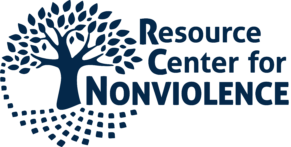7 MYTHS ABOUT NONVIOLENCE—and what is it really?
What is nonviolence? Here are some myths about nonviolence that you may not know about! Dr. Martin Luther King Jr. was convinced that, “the choice today is no longer between violence and nonviolence. It is either nonviolence or nonexistence.”
1. Nonviolence is the absence of violence
Most people equate nonviolence to be just as the word says, no violence. Nonviolence, however, is more than the absence of violence, it is a social justice tactic and a philosophy that people live by
2. Nonviolence is synonymous with passivity
While passivity as not engaging in violence is a part of nonviolence and its history, nonviolence is not only about committing actions without violence, but with the intention of actively reducing or eliminating violence. Scholar and activist Stellan Vinthagen explains that in addition to being “without violence,” it must also be “against violence.”
3. Nonviolence is not the choice for the brave
Choosing to engage in nonviolence entails making sacrifices and adhering to your values regardless of the violence around you. Those choices are not made by the cowardly and nonviolence is a choice for the brave
4. The most successful nonviolent movements arise and progress spontaneously
Nonviolent movements take a lot of work; they gain progress through time and while they could be inspired by spontaneous social injustices, we need active members providing visibility to the movement who are constantly working towards their cause. Recently, there has been a call for a moral revival, sparking the resurrection of the Poor People’s Campaign and social movements have been arising for the past few months, also inspiring the RCNV to have the Santa Cruz County Poor People’s Campaign, a feat that has taken time and planning rather than spontaneity.
5. Nonviolence may be morally superior, but it’s useless against a brutal leader
Nonviolence is not just the moral choice; it is almost always the strategic choice. Srdja Popovic of Waging Nonviolence explains that, “their biggest objection to violence is the fact that it simply doesn’t work.” Using violence could possibly gain a few followers but could also throw away the support of millions, support that could have been won with nonviolence.
6. Nonviolent movements require charismatic leaders who give inspiring speeches
Nonviolent movements are often associated with charismatic leaders such as Dr. Martin Luther King Jr. or Gandhi, but it isn’t a requirement. People power is greatly needed and those behind the scenes have the same ability to create change. Otpor the Serbian political organization turn movement wasn’t characterized by its speeches and they had multiple representatives that spoke for them. This was a form of tactical nonviolence, making sure that everyone was a gear in the machine and had their own purpose and significance.
7. Nonviolent resistance is fighting an ‘enemy’
Often in times of conflict, there is an enemy that we fight against. With nonviolence, the fight for our freedom is also the fight for everyone’s freedom, including those who may not agree with us. Nonviolence fights the injustices within the system rather those within, inspiring us to also actively try to change their hearts and minds. Archbishop Desmond Tutu’s Ubuntu philosophy explains that everyone’s liberation is indelibly connected.
Nonviolence is multi-faceted and learning what it truly is, is a constant learning experience. At the Resource Center for Nonviolence, there are so many ways to participate and learn!
More events to learn about nonviolence:
TOMORROW, AUGUST 14! We will have the 5th and LAST study session of Nonviolent Resistance: Personal and Political. Come join us 7 PM Tuesday Night where we will explore more facets of nonviolence guided by the writings and experiences of well-known activists as well as our own. For more info, e-mail Peter at peter@rcnv.org.
Want to learn more?
We have our Fall Kingian Nonviolence Conflict Reconciliation Training coming up real soon!
Saturday and Sunday, NOVEMBER 17-18, 10AM-6PM. This is a two-day conflict reconciliation training that provides tools to help you reconcile conflicts with nonviolent principles within your community and in your personal lives! Breakfast and lunch provided both days. This training will be paid for by the Goft Economics Model, similar to sliding scale, which will be explained at the training—no one will be turned away for lack of funds.
REGISTER NOW –> HERE
For more info about Kingian Trainings, e-mail Drew at drew@rcnv.org.
